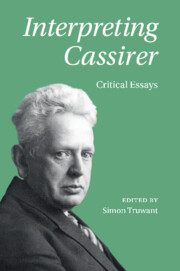Book contents
- Interpreting Cassirer
- Interpreting Cassirer
- Copyright page
- Contents
- Contributors
- Acknowledgments
- Abbreviations
- Introduction
- Part I Cassirer’s Philosophy of Culture
- Chapter 1 Interaction between Language and the Other Symbolic Forms
- Chapter 2 The Status of Art in Cassirer’s System of Culture
- Chapter 3 Being in Time
- Chapter 4 Science As a Symbolic Form: Ernst Cassirer’s Culture of Reason
- Chapter 5 Quantum Mechanics As the Ultimate Mode of Symbol Formation
- Chapter 6 Spirit in the Age of Technical Production
- Chapter 7 Political Myth and the Problem of Orientation
- Part II Cassirer’s Philosophy of Consciousness
- Part III Cassirer’s Philosophical Method
- Bibliography
- Index
Chapter 1 - Interaction between Language and the Other Symbolic Forms
from Part I - Cassirer’s Philosophy of Culture
Published online by Cambridge University Press: 17 April 2021
- Interpreting Cassirer
- Interpreting Cassirer
- Copyright page
- Contents
- Contributors
- Acknowledgments
- Abbreviations
- Introduction
- Part I Cassirer’s Philosophy of Culture
- Chapter 1 Interaction between Language and the Other Symbolic Forms
- Chapter 2 The Status of Art in Cassirer’s System of Culture
- Chapter 3 Being in Time
- Chapter 4 Science As a Symbolic Form: Ernst Cassirer’s Culture of Reason
- Chapter 5 Quantum Mechanics As the Ultimate Mode of Symbol Formation
- Chapter 6 Spirit in the Age of Technical Production
- Chapter 7 Political Myth and the Problem of Orientation
- Part II Cassirer’s Philosophy of Consciousness
- Part III Cassirer’s Philosophical Method
- Bibliography
- Index
Summary
This chapter explores the ways in which language is related to the other symbolic forms in Cassirer’s philosophy of culture. Like myth, religion, art, and science, language is a distinct symbolic form, yet at the same time it always appears in the context of other human activities. This means that whenever we talk about language as a symbolic form, we are forced to think of it relationally, in and through the different aspects of language that come into focus through the perspectives of the other forms. Leib distinguishes three constitutive functions of language: its sign function, its mediation between the “I” and the world, and its ability to encapsulate a “worldview” as a totality for consciousness. On the basis of these functions, he shows how language, as a medium for expression, reorganizes itself when aligning with myth, religion, art, science, and history. Ultimately, Leib argues that myth is an immanent possibility of language that remains active even in today’s “labile equilibrium” of culture.
- Type
- Chapter
- Information
- Interpreting CassirerCritical Essays, pp. 13 - 33Publisher: Cambridge University PressPrint publication year: 2021

